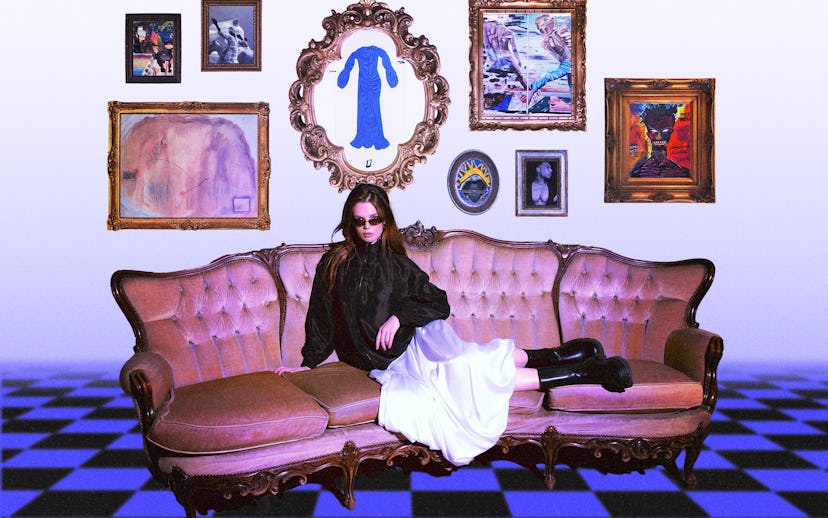
Culture
Young Art Collectors Are Carving Out A Space For Themselves
“I wouldn’t say that the art world is changing shape for them; I would say they’re changing the art world for themselves.”
Over the course of this year, New York multimedia artist Diana Rojas has noticed that those looking to purchase her work are getting younger—younger even than her. “I thought that was really special,” says Rojas, who just turned 30.
As a young artist and collector — the first piece in her collection was a painting by Emma Kohlmann that she received as a gift — Rojas is already spotting differences in the art buyers of different generations. For starters, Rojas says Gen Z art collectors are looking for more of a connection with a work, rather than monetary value. “It feels genuine,” she says. “It feels like there’s a desire to put the sculpture up on your coffee table and nightstand, whereas perhaps older collectors may put a piece into storage to hold onto it as a future investment.” While the act of buying and selling art for a profit is by no means going anywhere, are young people paving the way for a new type of art collector to emerge?
Paul Hill, the 24-year-old founder of Strada, started the art gallery and online marketplace in 2021 as a way of providing a “bunch of solutions” to different problems he saw in the art world. “I saw a pretty antiquated system where a lot of galleries and artists are limited in how they’re able to expand their collector base, increase their sales, and also build community around themselves because of the isolating industry,” he tells NYLON. One of the main solutions Hill wants to provide with Strada is expanding the reach of artworks, not only for galleries and makers but also to increase sales.
While Strada’s exhibition-level artwork — typically priced between $10,000 and $50,000 — is not affordable for most young collectors, Hill says the gallery has had a couple of “extremely wealthy Gen Z people” come into the Lower Manhattan space and buy artwork. Strada’s other young collectors are going through its Design Lab, which features a collection of functional artworks for the home. There, price points are within the hundreds, and the pieces are sold exclusively online through social channels like its TikTok Shop. In December, Strada will run Design Lab popups in the gallery space and launch its expansion into online-only art auctions.
Young people today have already shown a dedicated interest in collecting art. Last year, Art Basel reported Gen Z art collectors spent more than 30% of their net worth on buying art, and the Art Basel and UBS Survey of Global Collecting 2023 report found Gen Z collectors had the highest average expenditure on prints and digital art. This follows the data that people younger than 40 are the fastest-growing age group of art buyers, with women being the biggest spenders. Despite this, Hill says, young aspiring art collectors are still met with barriers.
“As a generation, we’re expanding what art is as well as who can be involved with art.”
“The art world thrives on inaccessibility, and money and network are the two main things,” he says. These barriers, he says, are limiting for both the consumer (collectors) as well as the industry (galleries). “We can really broaden the amount of collectors by making things more accessible, and it helps more artists sell their artworks as well.” Hill encourages first-time buyers to look at early college programs at universities with great art schools and even reach out to artists over DM.
For Hannah Traore, founder and director of Hannah Traore Gallery, making the art world more open to young art collectors and artists alike means carving out new spaces. “We don’t need to ask for a seat at the table; we can make our own,” she says. Traore started collecting in college, beginning with buying work from her friends. She now collects one piece from every show at her gallery, which she opened in January 2022. “I’m an extremely sentimental person, and it would kill me to fully have to say goodbye to each exhibition,” she says.
Traore says younger collectors are less caught up in the rules of the art industry that existed before them. “I wouldn’t say the art world is changing shape for them; I would say they’re changing the art world for themselves,” she says. This shift includes switching to digital-only platforms and buying pieces through social media exchanges. It also means redefining what being a “collector” means. “We’re seeing a huge rise of archival fashion people who are seeking out jackets and pants that cost almost as much as an emerging artist’s painting,” says Hill. “As a generation, we’re expanding what art is as well as who can be involved with art.”
While previous generations may have deemed art collection as a game for those older, more established, or egregiously wealthy, young collectors and the galleries that cater to them are coming up with an entirely new set of rules. Buying a ceramic from Strada’s TikTok Shop? You’re a collector. Investing in a designer vintage jacket? That’s collecting, too. For Rojas, even the act of creating her work itself is a tool for collection. “Whether it’s shoes or certain trends happening, I get a desire to make them and, in a way, have them myself.” The outcome is Rojas’ iconic ceramic sculptures — pieces that you too, over DM or email, can collect.
This article was originally published on